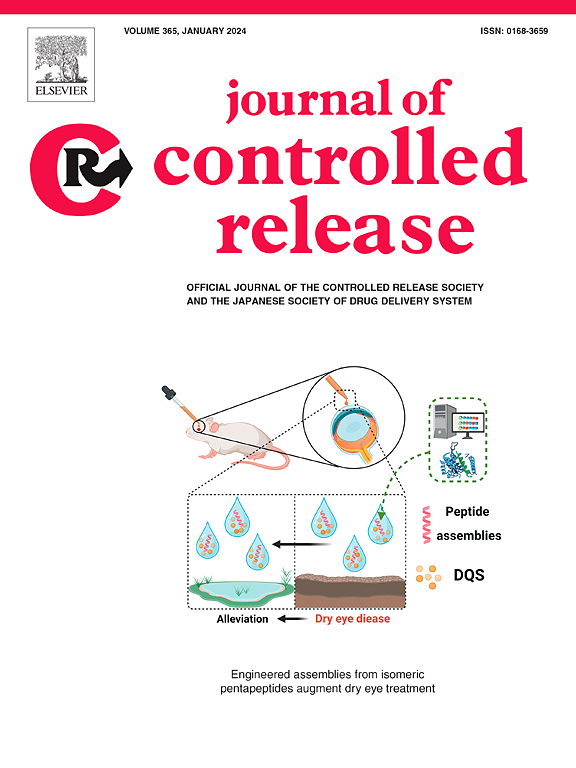双功能hCe-pHEMA隐形眼镜,用于眼部抗生素释放、抗氧化保护和体内角膜细菌感染治疗
IF 10.5
1区 医学
Q1 CHEMISTRY, MULTIDISCIPLINARY
引用次数: 0
摘要
眼部细菌感染通常与活性氧(ROS)水平升高有关。然而,对于眼部细菌性角膜炎(BK)的治疗,眼药水或眼膏中的广谱抗生素无法抑制ROS,并且会迅速清除并降低生物利用度。本研究开发了抗生素左氧氟沙星(LEV)负载的中空铈纳米颗粒(hCe NPs, ROS清除剂),将其嵌入聚甲基丙烯酸羟乙基(pHEMA)水凝胶中,制备双功能隐形眼镜(LEV@hCe-pHEMA),从而延长眼部药物递送时间并提高生物利用度。在pHEMA隐形眼镜中集成LEV@hCe NPs可保持良好的透光性(>;90.0 %),增强了紫外线阻挡能力(200-400 nm),实现了可控的LEV释放(120 h内84.2 %),增强了ROS清除抗氧化能力(60 min内78.4 %)。体外细胞毒性评价表明,hCe-pHEMA隐形眼镜具有较低的细胞毒性(细胞存活率>;95.0 %),具有良好的生物相容性。值得注意的是,LEV@hCe-pHEMA对金黄色葡萄球菌ATCC29213(89.8% %)和大肠杆菌ATCC25922(94.2 %)具有显著的抗菌效果,显示出其治疗潜力。在兔模型的体内安全性评估中显示,在7天的佩戴期间,hCe-pHEMA镜片没有眼部刺激或病理变化,证实了hCe-pHEMA镜片具有良好的生物相容性。LEV@hCe-pHEMA隐形眼镜可用于治疗金黄色葡萄球菌诱导的兔BK模型。可在7 天内几乎完全去除角膜炎,减少角膜水肿,进一步恢复角膜透明度。结果表明,LEV@hCe-pHEMA隐形眼镜可以作为一种有前景的双功能智能眼部药物输送系统,用于非侵入性眼部治疗。本文章由计算机程序翻译,如有差异,请以英文原文为准。


Dual-functional hCe-pHEMA contact lenses for ocular antibiotic release, antioxidant protection, and in vivo corneal bacterial infection treatment
Ocular bacterial infections are typically associated with elevated levels of reactive oxygen species (ROS). Nevertheless, for treating ocular bacterial keratitis (BK), broad-spectrum antibiotics in eye drops or ointments are unable to inhibit ROS and encounter swift clearance and reduced bioavailability. This work developed antibiotic levofloxacin (LEV)-loaded hollow ceria nanoparticles (hCe NPs, ROS scavengers), which were embedded into poly-hydroxyethyl methacrylate (pHEMA) hydrogels to prepare dual-functional contact lenses (LEV@hCe-pHEMA), enabling extended ocular drug delivery and enhanced bioavailability. The integration of LEV@hCe NPs within pHEMA contact lenses preserved good optical transmittance (> 90.0 %), fortified UV-blocking capacities (200–400 nm), achieved controllable LEV release (84.2 % within 120 h), and enhanced ROS scavenging-antioxidative potential (78.4 % within 60 min). In vitro cytotoxicity evaluations revealed low cytotoxicity (cell viability >95.0 %) of the hCe-pHEMA contact lenses and affirmed their good biocompatibility. Notably, LEV@hCe-pHEMA exhibited significant antibacterial efficacy against S. aureus ATCC29213 (89.8 %) and E. coli ATCC25922 (94.2 %), demonstrating their therapeutic potential. In vivo safety evaluations in rabbit models showed no ocular irritation or pathological changes during a 7-day wearing period, confirming the good biocompatibility of the hCe-pHEMA lenses. LEV@hCe-pHEMA contact lenses could be utilized to treat rabbit BK model induced by S. aureus. It could near-completely remove the keratitis (within 7 days), reducing corneal edema and further recovering corneal transparency. The results suggested that LEV@hCe-pHEMA contact lenses could be employed as promising dual-functional smart ocular drug delivery systems for non-invasive ocular therapy.
求助全文
通过发布文献求助,成功后即可免费获取论文全文。
去求助
来源期刊

Journal of Controlled Release
医学-化学综合
CiteScore
18.50
自引率
5.60%
发文量
700
审稿时长
39 days
期刊介绍:
The Journal of Controlled Release (JCR) proudly serves as the Official Journal of the Controlled Release Society and the Japan Society of Drug Delivery System.
Dedicated to the broad field of delivery science and technology, JCR publishes high-quality research articles covering drug delivery systems and all facets of formulations. This includes the physicochemical and biological properties of drugs, design and characterization of dosage forms, release mechanisms, in vivo testing, and formulation research and development across pharmaceutical, diagnostic, agricultural, environmental, cosmetic, and food industries.
Priority is given to manuscripts that contribute to the fundamental understanding of principles or demonstrate the advantages of novel technologies in terms of safety and efficacy over current clinical standards. JCR strives to be a leading platform for advancements in delivery science and technology.
 求助内容:
求助内容: 应助结果提醒方式:
应助结果提醒方式:


